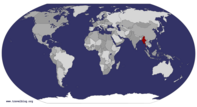Published: April 15th 2009

 37 Nat Spirit Medium Festival Burma 2009.
37 Nat Spirit Medium Festival Burma 2009.
Spirit Medium waiting to preform in the shrine of the 'Two Brothers' Tung Byone Village, Myanmar/Burma August.2008.The Main 37 Nat Spirit Medium (Nat Kadaw) Festival (Pwe') held every year for 5 days in Burma/Myanmar in the Three Hundred year old Village of Tung - Byone, followed by consecutive smaller scale events in Amarapura and Mount Popa or any of the smaller Nat Pwe's held throughout 'Burma' so it is substantially what the forthcoming website
mention here that Magic, Sorcery, Alchemy all the arts in fact can cross over into Nat Worship Cult and there are lots of a Nat Kadaws who may or may not practice alchemy,magic, sorcery and some that do it is a completely individual choice.
100,000's of people attend the Festival of Tung Byone it's the biggest Nat Spirit Festival in Myanmar they attend to receive blessing's and good luck and guidance from the Nat's Via Spirit Mediums the festival is based on the true nature of the Burmese Pwe' Music Song Dance and Performance.








